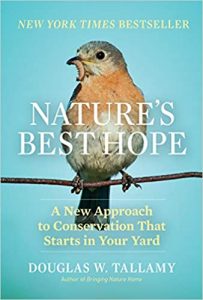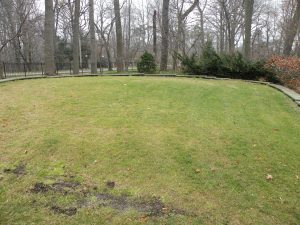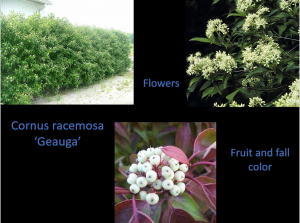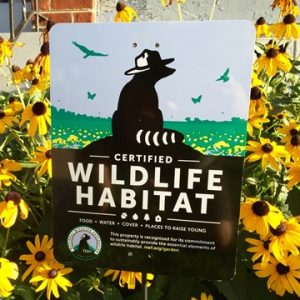 Holidays are usually a joyful time but this year, our holidays are fraught with indecision, fear, and sadness: Indecision and fear – is it safe to gather? Sadness for those who have died and won’t be with us.
Holidays are usually a joyful time but this year, our holidays are fraught with indecision, fear, and sadness: Indecision and fear – is it safe to gather? Sadness for those who have died and won’t be with us.
 As we find ourselves unable to socialize with our friends and family, the upside is that we have more time to read. In past blogs, I have written about the environmental threat posed by climate change and what we can do to help it. I’ve recently read frightening statistics that demonstrate that we are losing species of flora and fauna at an alarming rate due to climate change. In that vein, I highly recommend Douglas Tallamy’s new book Nature’s Best Hope: A New Approach to Conservation That Starts in Your Yard.
As we find ourselves unable to socialize with our friends and family, the upside is that we have more time to read. In past blogs, I have written about the environmental threat posed by climate change and what we can do to help it. I’ve recently read frightening statistics that demonstrate that we are losing species of flora and fauna at an alarming rate due to climate change. In that vein, I highly recommend Douglas Tallamy’s new book Nature’s Best Hope: A New Approach to Conservation That Starts in Your Yard.
While various government entities are slow to move, Doug Tallamy posits that we, as individuals, can turn our yards into conservation corridors that will provide habitats for wildlife. Most habitat now is too fragmented to sustain one species, much less biodiverse species. “Creating biological corridors will enlarge the populations of plants and animals within protected habitat, enabling them to weather normal population fluctuations indefinitely.”

Large lawn panel that could easily be converted to groundcover, at the very least.
Tallamy tells us that the conservation approaches of the twentieth century, i.e. preserves and national parks, are not nearly enough to save biodiversity. Conservation has to be everyone’s responsibility. We need to redesign public and private landscapes that convert at least half of the area now in lawn to attractive landscapes that are packed with plants and contribute to local ecosystems instead of destroying them.
Changing the lawn mindset will not be easy because, for three hundred years in America, lawn has been a status symbol that signified wealth and good citizenship. Doug believes that two factors can help us change the lawn culture: the cost of irrigation and ecological landscape design that reduces lawn, adding native plants wherever possible, and, eventually, using lawn as pathways only.

A Cleveland plant lover’s front yard with no lawn
This ecological landscape should not be confined to the back yard. Good design is acceptable to everyone. It could be as simple as adding one oak tree to the front yard. Although there are studies about ecosystem functionality, most of us do not realize that the stability and ability of this functionality is related to the number of species in it and the coevolved relationship between the flora and fauna. It is imperative, therefore, that we create ecosystems, not just landscape decoration.

Cornus racemosa Geauga®-collage
Most people are disdainful of insects even though they sustain the earth’s ecosystems by sustaining the plants and animals that compose the ecosystems (Tallamy elaborates on this statement). When native plants are destroyed and/or replaced with introduced plants, insect populations are greatly reduced. Tallamy cites many different studies in his book but one that I was particularly interested in was about the difference in the fat content of berries that birds eat in the fall to make up for the loss of insects. Those of introduced plants had far less fat (necessary to survive the winter) than those of native plants. One of the native plants cited in the study was Gray Dogwood (Cornus racemosa), a plant that I love and use in many of my designs for its site adaptability and its seasons of interest. Sadly, this dogwood is not used nearly enough. Although the species is quite large, there are several cultivars that I find quite useful.
We need plants to sustain insects and animals but which ones do we need the most? Tallamy says that we should focus on enhancing the populations of insects that have the greatest impact on terrestrial ecosystems: those that are the most edible and most nutritious and those responsible for most of the pollination required by plants. Therefore, we should be focusing on caterpillars, sawflies, and native bees. Since caterpillars are the mainstay of most bird diets, we need to know which plants are the best hosts for caterpillars. This will vary by locality but fortunately, there are tools that we can all use. We can go to the National Wildlife Federation website and just put in “native plant finder.” The ranked list of plants that support the most caterpillars, both woody and herbaceous plants, will pop up for your zip code, wherever you are in the country. The Audubon Society has created a similar website.
The research has found that there are a few “keystone” genera – Quercus (Oak), Prunus (Cherry), Salix (Willow) – that remain the same across the country. Not being an entomologist, it never occurred to me that caterpillars crawl off their host plants before pupating and that we need to provide a safe space for that developmental stage. Caterpillars evidently need leaf litter in which to spin their cocoons but if they drop off a tree surrounded completely by lawn, they need to crawl further. The answer is surrounding our trees with groundcover or shrub and perennial beds.
Native bees need nesting sites, flowers in bloom throughout the seasons from which to gather nectar and pollen, and water. The majority of native bees nest in the ground but, if you believe as I do that the notion of fall cleanup is antithetical to nature’s cycles, you will be doing a favor for the bees that nest in the pithy stems of perennials.

Certified Wildlife Habit sign from National Wildlife Federation
Going back to the notion of ecological landscape design, Tallamy envisions a Homegrown National Park that is composed of multitudinous properties, many of them in the suburbs and quite small. A starting place has been the National Wildlife Federation program of certified wildlife habitats. To be eligible, one must be able to check off a list of attributes. However, this does not mean that the gardens are well designed. I believe that is the next step and, in many instances, it means changing the regulations of homeowners associations. What can we as individuals do? Tallamy lists ten steps that each of us can take.
This book is a mere 254 pages but not one that you can breeze through. It is quite thought provoking and one you should definitely read if you want to be involved in making our world a better place – for us and for future generations.


0 Comments